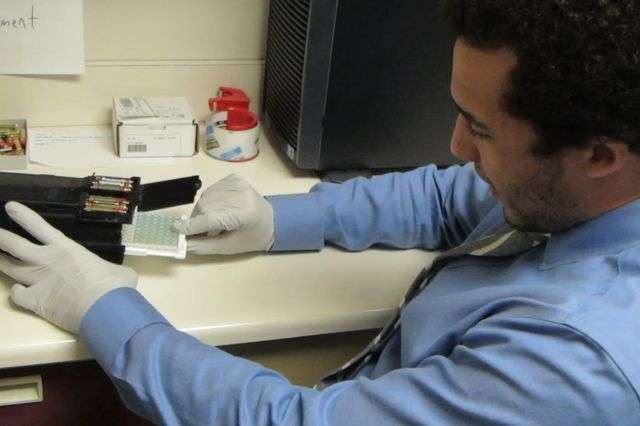Researchers create smartphone-based device that reads medical diagnostic tests quickly and accurately

Enzyme-linked immunosorbant assay, or ELISA, is a diagnostic tool that identifies antigens such as viruses and bacteria in blood samples. ELISA can detect a number of diseases, including HIV, West Nile virus and hepatitis B, and it is widely used in hospitals. It can also be used to identify potential allergens in food, among other applications.
A team of researchers from the California NanoSystems Institute at UCLA has developed a new mobile phone-based device that can read ELISA plates in the field with the same level of accuracy as the large machines normally found in clinical laboratories.
The research, published online in the journal ACS Nano, was led by Aydogan Ozcan, associate director of the California NanoSystems Institute, along with Dino Di Carlo, professor of bioengineering, and Omai Garner, associate director of clinical microbiology for the UCLA Health System. UCLA undergraduate Brandon Berg was the study's first author, and two other undergraduates also contributed to the research.
"It is quite important to have these kinds of mobile devices, especially for administering medical tests that are usually done in a hospital or clinical laboratory," said Ozcan, who is also Chancellor's Professor of Electrical Engineering and Bioengineering. "This mobile platform can be used for point-of-care testing, screening populations for particular diseases, or tracking vaccination campaigns in most resource-poor settings. It's fantastic for an undergrad to be first author on the publication."
Traditional ELISA testing is performed with small transparent plates that resemble honeycombs, typically with 96 tiny wells. Samples are placed in the wells first, followed by small amounts of fluid containing specific antibodies that bind to antigens in the samples. These antibodies are linked to enzymes, so when a substance containing the enzyme's substrate—the molecule the enzyme acts upon—is added, the resulting chemical reactions cause a change in color. This color change is then analyzed to detect and quantify any antigens that may be present.
The new device, which is created with a 3D printer and attaches to a smartphone, illuminates the ELISA plate with an array of light-emitting diodes. The light projects through each well and is collected by 96 individual plastic optical fibers in the attachment. The smartphone transmits the resulting images to UCLA servers through a custom-designed app. The images are then analyzed by a machine-learning algorithm that the researchers wrote for this purpose, and the diagnostic results are sent back to the phone within about one minute for the entire 96-well plate. The app also creates a visualization of the results for the user.
This mobile platform was compared with the standard FDA-approved well-plate readers in a UCLA clinical microbiology laboratory. The ELISA tests included those for mumps, measles, and herpes simplex viruses 1 and 2. With a total of 571 patient samples used in the comparison, the mobile platform achieved 99.6 percent accuracy in diagnosing mumps, 98.6 percent for measles, and 99.4 percent each for herpes simplex 1 and 2.
"Our team is focused on developing biomedical technologies that work with mobile platforms to assist with on-site testing and health-care in disadvantaged or rural areas," Berg said.
"We are always looking toward the next innovation, and are looking to adapt the basic design of this ELISA cell-phone reader to create smartphone-based quantified readers for other important medical tests," Di Carlo said.
More information: "Cellphone-Based Hand-Held Microplate Reader for Point-of-Care Testing of Enzyme-Linked Immunosorbent Assays." ACS Nano, Article ASAP DOI: 10.1021/acsnano.5b03203
Journal information: ACS Nano
Provided by University of California, Los Angeles


















